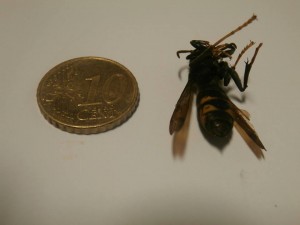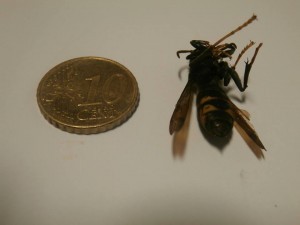Recently, much attention has been given to the Asian hornet in Portugal. This insect belongs to the “vespa velutina” species. It is one of the largest hornet species. It measures about 30 mm and the queen may measure up to 35 mm. The body is predominantly dark brown or black with some yellow stripes and the legs are brown with yellow tips.
This species is native of tropical and subtropical regions of Eastern Asia. In 2004, it was first seen in Europe, in France, where it was probably unintentionally brought in through agricultural trade. Later it was detected and considered an invasive species in Spain, Portugal, Belgium and Italy. It is expected that it will spread through all the European continent in the next years. In France, the invasion progresses about 60 km per year. In Portugal, the first specimen of this species was found in 2011.
The Asian hornet feeds on bees and other invertebrates, mainly on pollinators. From June to November, the colony grows markedly. Therefore, it is then that there is a bigger search for food by this species.
The Asian hornets frequently raid European bee nests to catch larvae. Their attack method is very efficient. When they find a hive, the hornets wait on its proximity for the arrival of worker bees carrying polen back to the hive. There, they kill them and carry only their thoraxes (the most nutritious part) back to their nests, where they are feed to the larvae. About 30 hornets are enough to kill about 30 000 bees.
The Asian hornets prefer to build their nests at the top of trees reaching more than 5 m height. The height of the nests measures up to 1.80 m and the width measures up to 80 cm. The shape of the nests is either round or oval.
The nests are built from paper pulp made with hornets spit and wood fibers. In Annex 2 some photos show pieces of Asian hornets nests.
Each nest may accomodate about 2000 hornets and 150 colony-founding queens. The following year, each of these queens may found, at least, six new nests.
Probably, one of the reasons for the nests going unnoticed during a long time after they have been set is the fact that they are built on top of high trees. The nests are frequently found out in winter, after the trees shed their leaves.
In Portugal, most nests have been found in the north, mainly in the regions between the Minho and Lima rivers. Some experts believe that in ten years all the Iberic Peninsula will be colonized. However Eng. Henrique Martins, who is working in a team that fights the Asian hornet invasion, told me that the spread speed is really unknown. Since the Asian hornet has only recently arrived to Europe, there is still no reliable data about the spread speed.
Eng. Henrique Martins also told me that Asian hornets are considered a threat in Europe because they have no predators. They are not an environmental problem in the Asian countries where they come from, because there they live in ecological balance with the other native species. Besides, in Portugal, the climate is favorable to them. Since winters are not very harsh, they don’t need to hibernate and they remain active all year long. That’s not the case for other European regions where they’ve settled.
It is worrisome that the territory colonized by Asian hornets is rapidly expanding. This problem asks for prompt actions because it is a serious threat to the bee populations, which have been severely declining in recent decades on account of fungi, pesticides, climate changes and habitat destruction.
The following sentence, which is generally but incorrectly accredited to Einstein, has been used to warn us about the danger to the human species linked to the extinction of the pollinator bees.
“If the bee disappeared from the surface of the Earth, man would only have four years left to live.”
Our fate would probably not be as doomed as stated, but there would be extreme effects on Earth. A third of our food (vegetables and fruits) needs to be pollinated by insects. The European bees are in charge of 80% of all pollination. Therefore, the extinction of pollinator bees would be dreadfully harmful for the human being.
It is then extremely important that we all collaborate to stop the Asian hornets from spreading. The most efficient way of exterminating them is to destroy their colonies. As soon as a nest is found, its location must be announced to those authorities that are prepared to deal with the problem, such as the Fire Fighters. The Fire Fighters destroy the nests by incinerating them.
By personal experience, we recommend that, after the nest is incinerated, someone verifies if it is indeed completely destroyed. Last winter, a neighbour warned us about an Asian hornet nest set on the top of one of our highest trees. The Fire Fighters were called and burned the nest. However, they left without verifying that the nest had been totally destroyed. When we checked it, we realized that a big part of its structure had not been damaged. The nest had fallen before being totally incinerated. The colony had been affected, but not completely destroyed. The task was finished by my father, who burned the remaining nest.
In spring, the land that surrounds my house has lots of flowers and by then we can see lots of bees collecting polen. The bees that we are used to see flying around would be doomed if the nest had not been destroyed. Fortunately, the danger that threatened the bees that visit our ground disappeared and our orchard ecosystem was preserved.







You must be logged in to post a comment.